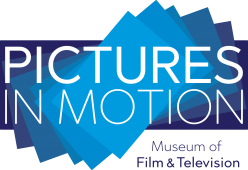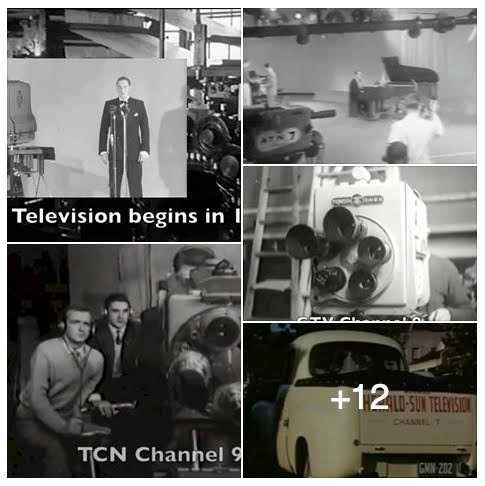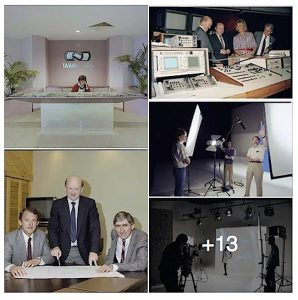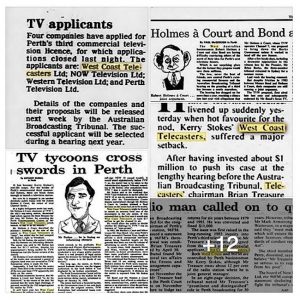The Turbulant 1980s Era of WA Television
When television first started in Australia in 1956, the four commercial licenses were granted to newspaper proprietors, in both Sydney and Melbourne.
- Channel Nine, Sydney, went to Frank Packer’s The Daily Telegraph.
- Channel Seven, Sydney, went to a subsidiary of Fairfax, which owned the Sydney Morning Herald.
- Channel Nine, Melbourne, went to a consortium which included two newspapers, The Argus and The Age.
- Channel Seven, Melbourne, was originally owned by The Herald and Weekly Times Limited, owners of The Herald and The Sun.
Then in 1959, Brisbane, Adelaide and Perth got their turn.
- Channel Nine, Brisbane, went to Fairfax.
- Channel Seven, Brisbane, went to Queensland Press, owned by the Herald group.
- Channel Nine, Adelaide, was owned by Rupert Murdoch, who also owned The News newspaper.
- Channel Seven, Adelaide, was owned by the Advertiser Newspapers, then controlled by The Herald and Weekly Times.
- Channel Seven, Perth, went to a West Australian Newspapers subsidiary.
The “Greed is Good” notion took over business ethics in the 1980s, which led to the stock market crash of 1987. A great upheaval that caused corporate raiders to come unstuck, empires to be lost and fortunes to vanish.
Meanwhile, Government legislative changes, and reduced regulation, had a big impact on the media, allowing it to be more concentrated with less owners. Then new technology helped centralise program distribution in Sydney and Melbourne, with an increasing tendency for content production to be concentrated there also.
The influence of Sir James Cruthers, Brian Treasure, Robert Holmes a Court, Alan Bond, Christopher Skase and even Laurie Connell will be covered. The NEW-10 licence fight will also be covered along with all the players.
On Wednesday the 20th April, 2016, The Australian Museum of Motion Picture and Television (AMMPT) will conduct a presentation that will track how the transition in television ownership took place during the 1980s. Much of it determined by political decisions and business opportunities for the powerful elite. This brought about a restructuring of the industry. A process that continues to this day, influenced by the party in power and the lobbying power of the media moguls.
One person who faired poorly out of the NEW-10 licence application was Ross McDonald, who had established TIAMAC as a television facility with three studios for commercial production.
In 1983, Ross built a three-studio complex in North Perth for 5.7 million dollars, for his Taimac Video Corporation, which merged with the Shepherd Baker Studio, formed by former West photographers Mike Baker and Don Shepherd. Together they formed Taimac SBS, with Ross McDonald as the Chairman.
Then came the Federal Government’s decision to grant a third commercial television licence in Perth.
The Australian Broadcasting Tribunal received submissions from four applicants for the third commercial licence: West Coast Telecasters, Now Television, Perth Television and Western Television.
The high cost of maintaining expensive legal counsel had forced two of the initial applicants out of the race.
It took 117 days of hearings and around $6 million – most of it on lawyers’ fees – to reach a conclusion.
With the lawyers’ bills mounting to around $900,000, Taimac took a controlling partner, local merchant banker Laurie Connell.
This dragged on in part due to the points of order raised by and the court challenges mounted by the existing licensees to the validity of the Tribunal hearings.
These challenges had been made possible by the uncertain legal status of the Tribunal as a quasi-judicial body. It had also been due to the added complication that the Tribunal had to decide on whether the licence be allocated on the VHF or UHF band.
TVW proposed the establishment in Perth of a “localised non-profit community television station, owned through a government commission or statutory body and drawing upon members of the community to direct and establish operating policy”.
The submission envisaged that, existing commercial licensees, government and sponsorship arrangements would combine to finance the alternative station.
Brian Treasure’s West Coast Telecasters, funded by Kerry Stokes and Jack Bendat, was the successful applicant, defeating Ross McDonald’s Western Television.
However, NEW-10 was sold to Frank Lowy’s Northern Star Holdings before they went to air. The reason for this was a change in government policy.
Ross McDonald is understandably bitter towards the Federal Government and a hearing system which allowed a company to win a licence on the basis of certain promises, which it then avoided by selling the licence.
Ross was prepared to honour his commitment, but he lost out on two accounts when Laurie Connell adversely impacted on his company.
During the 1980s, Laurie Connell started acquiring numerous local businesses through aggressive takeovers before setting himself up as a deposit taker for investors under the name of Rothwells Merchant Bank, which had begun its life as a Brisbane-based menswear chain.
Taimac was one of these companies.
Immediately after the October 1987 stock market crash, there was a run on the bank from local investors.
Connell put together a rescue package involving numerous Australian businessmen and approached the premier, Brian Burke, who provided a 150 million dollar government guarantee to provide short-term relief.
Rothwells ultimately went into liquidation, causing heavy losses to the government and Rothwells investors.
The fallout from Laurie Connell’s business dealings, led to the WA Inc Royal Commission, and ultimately claimed or marred at least three premiers — Ray O’Connor, Brian Burke and Peter Dowding. For Dowding organised the 400 million dollar purchase of a non-existent petrochemical company, part held by Connell.
This is only part of the NEW Channel 10 licence application story, which will be told in full on Wednesday the 20th April, 2016, when the Australian Museum of Motion Picture and Television (AMMPT) will conduct a presentation that will track how the transition in television ownership took place during the 1980s. Much of it determined by political decisions and business opportunities for the powerful elite. This brought about a restructuring of the industry. A process that continues to this day, influenced by the party in power and the lobbying power of the media moguls.
Here are a number of newspaper articles that deal with the epic Broadcasting Tribunal hearing which resulted in Kerry Stokes’ West Coast Telecasters winning the Channel TEN licence in Perth… then to sell the station before it opened.
These can be found on our Facebook page at: https://www.facebook.com/
The Australian Broadcasting Tribunal received submissions from four applicants for the third commercial licence: West Coast Telecasters, Now Television, Perth Television and Western Television.
The high cost of maintaining expensive legal counsel had forced two of the initial applicants out of the race.
It took 117 days of hearings and around $6 million – most of it on lawyers’ fees – to reach a conclusion.
West Coast Telecasters, however, was sold to Frank Lowy’s Northern Star Holdings before it went to air.
This is only part of the NEW Channel 10 licence application story, which will be told in full on Wednesday the 20th April, 2016, when the Australian Museum of Motion Picture and Television (AMMPT) will conduct a presentation that will track how the transition in television ownership took place during the 1980s.




